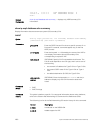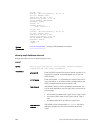
Version Description
8.3.11.1 Introduced on the Z9000.
8.3.7.0 Introduced on the S4810.
7.8.1.0 Added support for Multi-Process OSPF.
7.6.1.0 Introduced on the S-Series.
7.5.1.0 Introduced on the C-Series.
pre-6.1.1.1 Introduced on the E-Series.
Usage
Information
The following describes the show ip ospf process-id database network
command shown in the following example.
Field Description
LS Age Displays the LSA’s age.
Options Displays the optional capabilities available on router. The
following options can be found in this item:
• TOS-capability or No TOS-capability is displayed
depending on whether the router can support Type of
Service.
• DC or No DC is displayed depending on whether the
originating router can support OSPF over demand
circuits.
• E or No E is displayed on whether the originating router
can accept AS External LSAs.
LS Type Displays the LSA’s type.
Link State ID Displays the Link State ID.
Advertising Router Identifies the router ID of the LSA’s originating router.
Checksum Identifies the link state sequence number. This number
enables you to identify old or duplicate LSAs.
Length Displays the Fletcher checksum of an LSA’s complete
contents.
Network Mask Displays the length in bytes of the LSA.
Attached Router Identifies the IP address of routers attached to the network.
Example
Dell#show ip ospf 1 data network
OSPF Router with ID (20.20.20.5) (Process ID 1)
Network (Area 0.0.0.0)
LS age: 1372
Options: (No TOS-capability, DC, E)
LS type: Network
Link State ID: 202.10.10.2
Advertising Router: 20.20.20.8
LS Seq Number: 0x80000006
Checksum: 0xa35
1316
Open Shortest Path First (OSPFv2 and OSPFv3)


















